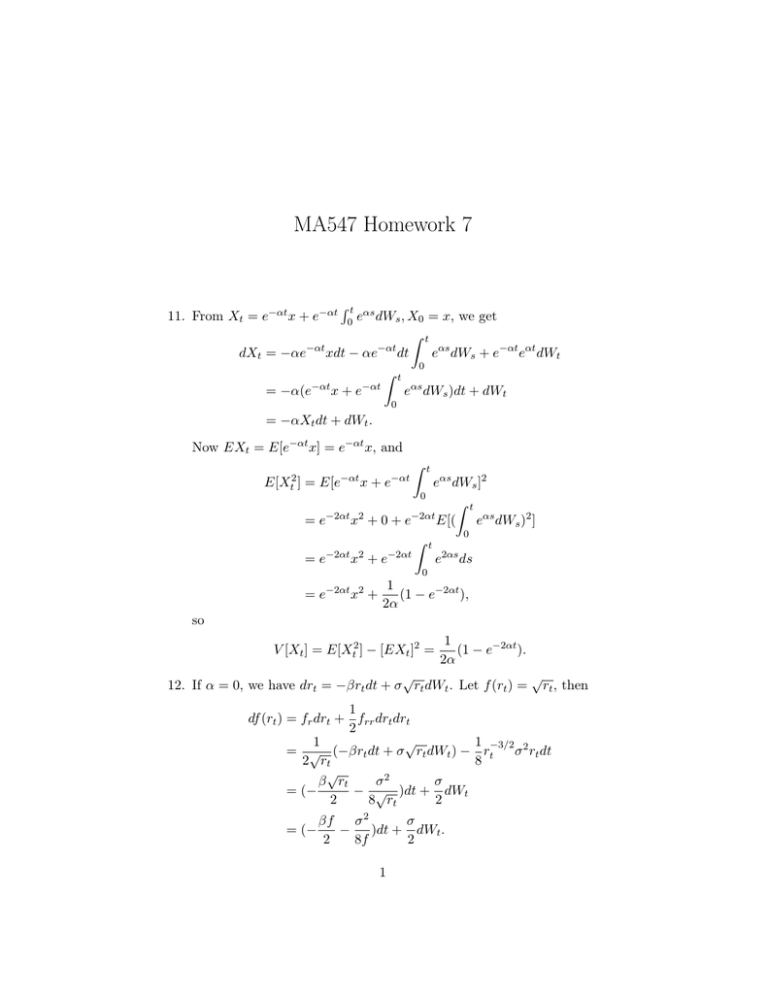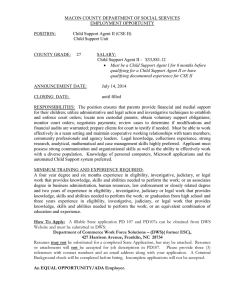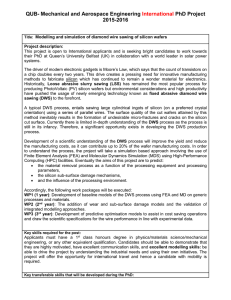Solutions
advertisement

MA547 Homework 7 Rt 11. From Xt = e−αt x + e−αt eαs dWs , X0 = x, we get Z t −αt −αt eαs dWs + e−αt eαt dWt dXt = −αe xdt − αe dt 0 Z t eαs dWs )dt + dWt = −α(e−αt x + e−αt 0 0 = −αXt dt + dWt . Now EXt = E[e−αt x] = e−αt x, and E[Xt2 ] −αt −αt Z t eαs dWs ]2 0 Z t −2αt 2 −2αt =e x +0+e E[( eαs dWs )2 ] 0 Z t e2αs ds = e−2αt x2 + e−2αt = E[e x+e 0 1 (1 − e−2αt ), = e−2αt x2 + 2α so V [Xt ] = E[Xt2 ] − [EXt ]2 = 1 (1 − e−2αt ). 2α √ √ 12. If α = 0, we have drt = −βrt dt + σ rt dWt . Let f (rt ) = rt , then 1 df (rt ) = fr drt + frr drt drt 2 √ 1 1 −3/2 2 = √ (−βrt dt + σ rt dWt ) − rt σ rt dt 2 rt 8 √ β rt σ2 σ = (− − √ )dt + dWt 2 8 rt 2 = (− βf σ2 σ − )dt + dWt . 2 8f 2 1 From du σ2 (t) = −βu(t) − u(t)2 , u(0) = θ, dt 2 we get du(T − t) σ2 = βu(T − t) + u(T − t)2 . dt 2 Let f (t, rt ) = e−u(T −t)rt , then 1 df (t, rt ) = ft dt + fr drt + frr drt drt 2 1 = fu u0 dt + fr drt + frr drt drt 2 σ2 = −rt e−u(T −t)rt (βu(T − t) + u(T − t)2 )dt 2 √ − u(T − t)e−u(T −t)rt (−βrt dt + σ rt dWt ) 1 + u(T − t)2 e−u(T −t)rt σ 2 rt dt 2 √ = −u(T − t)e−u(T −t)rt σ rt dWt . There is no drift term, so f (t, rt ) = e−u(T −t)rt is a martingale, that is MrT (θ) = E[e−u(T −t)rt ] = constant = e−u(T )r0 = E[e−θrT ]. First solve the ODE for u (Hint: divide both sides by u2 , let y = get y 0 = ay + b), we get θe−βt , 1 + γθ − γθe−βt σ2 u(0) = θ, γ = . 2β u(t) = So MrT (θ) = E[e−θrT ] = e−u(T )r0 = exp(− θe−βT r0 ). 1 + γθ − γθe−βT Now E[rT ] = −Mr0 T (θ)|θ=0 = e−βT r0 , E[rT2 ] = Mr00T (θ)|θ=0 = 2γ(1 − e−βT )e−βT r0 , V ar[rt ] = E[rT2 ] − E[rT ]2 = 2 σ2 (1 − e−βT )e−βT r0 − e−2βT r02 . β 1 u, Finally P (rT = 0) = P (0rT = 1) = E[0rT ] = E[(e−∞ )rT ] = MrT (∞) r0 e−βT = exp(− ) γ(1 − e−βT ) 2βr0 e−βT . = exp − 2 σ (1 − e−βT ) 14. Assume that St = f (t, Wt ). From Ito’s formula, we have 1 dSt = ft dt + fx dWt + fxx dt. 2 Since dSt = σSt dWt , we have 1 ft + fxx = 0 2 fx = σf, From the above, we get St = eσWt b (t) , where b(t) satisfies 1 b0 (t) + b (t) σ 2 = 0. 2 1 1 2 2 Solve it to get b (t) = Ke− 2 σ t . So St = KeσWt − 2 σ t . Suppose initially 1 2 we have S0 , then St = S0 eσWt − 2 σ t . Now we have Z t Z t Z t Su du = E[Su ]du = S0 du = S0 t. E[Yt ] = E 0 0 Also notice that St = S0 + E[Yt2 ] Z =E t Rt 0 σSs dWs , so 2 Z t Z Su du = E[ S0 + 0 Notice that Z tZ u 0 Z tZ σSs dWs du = 0 0 0 t u σSs dWs Z s 2 Rt E[Yt2 ] = E[ S0 t + 0 (t − s) σSs dWs ] 3 t (t − s) σSs dWs , 0 we can get 2 du ] 0 σSs dudWs = 0 R 2 Rt t = E[S02 t2 + 2S0 t 0 (t − s) σSs dWs + 0 (t − s) σSs dWs ] R 2 t = S02 t2 + 0 + E[ 0 (t − s) σSs dWs ]. Using Ito’s isometry, we can get R 2 t E[ 0 (t − s) σSs dWs ] Rt = E[ 0 (t − s)2 σ 2 Ss2 ds] Rt = 0 (t − s)2 σ 2 E[Ss2 ]ds Rt 2 = 0 (t − s)2 σ 2 S02 eσ s ds 2 0 Rt = S02 0 (t − s)2 eσ s ds Rt 2 = S02 −t2 + 2 0 eσ s (t − s) ds integration by parts Rt 2 = S02 −t2 − σ2t2 + σ22 0 eσ s ds 2 = S02 −t2 − σ2t2 + σ24 eσ t − σ24 . 2 So E[Yt2 ] = −S02 σ2t2 + S02 σ24 eσ t − S02 σ24 . Now we have V ar[Yt ] = E[Yt2 ] − E[Yt ]2 2 = −S02 t2 − S02 σ2t2 + S02 σ24 eσ t − S02 σ24 4 2 2S 2 = σ40 eσ t − 1 − σ 2 t − σ2 t2 . µ−ν 16. dXt = µdt + σdWt = νdt + σ µ−ν σ dt + dWt . We want σ t + Wt to be a Brownian motion under the new measure P? . Let θ = µ−ν σ , 1 Rt 1 2 2 then notice that E[e 2 0 θ ds ] = e 2 θ t < ∞, so Novikov’s condition is satisfied. Let Rt R 1 t 2 dP? Lt = = e− 0 θdWs − 2 0 θ ds dP which is µ−ν 1 µ−ν 2 e− σ Wt − 2 ( σ ) t By Girsanov’s theory, W̃t = µ−ν σ t + Wt is a Brownian motion under P? , and Xt = νt + σ W̃t is a Brownian motion with drift ν under P? . 18 Notice that there is no drift, so dXt = σdWt , i.e., Xt = X0 + σWt . By Feynman-Kac representation formula, the solution to ∂F 1 ∂2F (t, x) + σ 2 2 (t, x) = 0 ∂t 2 ∂x 4 with the terminal value condition F (T, x) = x4 = Φ (x) is F (t, x) = E[Φ (XT ) |Xt = x]. Notice that Xt ∼ N X0 , σ 2 t and Xt − Xs ∼ N 0, σ 2 (t − s) , which is independent of Xs , so we have F (t, x) = E[XT4 |Xt = x] = E[(XT − Xt + Xt )4 |Xt = x] = E[(XT − Xt )4 + 4x (XT − Xt )3 + 6x2 (XT − Xt )2 + 4x3 (XT − Xt ) + x4 |Xt = x] = E[(XT − Xt )4 ] + 0 + 6x2 E[(XT − Xt )2 ] + 0 + x4 Since E[(XT − Xt )2 ] = σ 2 (T − t) and from previous homework we know E[(XT − Xt )4 ] = 3σ 4 (T − t)2 , so the solution is F (t, x) = 3σ 4 (T − t)2 + 6x2 σ 2 (T − t) + x4 RT RT Since 0 σFx (t, x) dt = 0 12σ 3 x (T − t) + 4σx3 dt < ∞, so the condition for Feynman-Kac representation formula is satisfied, and the above F (t, x) is the desired solution. 20 We need to show that vθ (t, x) satisfies ∂vθ 1 ∂ 2 vθ (t, x) + σ 2 x2 2 (t, x) − rvθ (t, x) = 0. ∂t 2 ∂x By virtue of the definition of vθ , it is not hard to verify that 2 ∂vθ x ∂v θ (t, x) = · t, ; ∂t θ ∂t x 2 θ ∂ 2 vθ θ3 ∂ 2 v . (t, x) = · 2 t, 2 3 ∂x x ∂x x Therefore, we can get ∂vθ 1 ∂ 2 vθ (t, x) + σ 2 x2 2 (t, x) ∂t" 2 ∂x 2 2 2 2 # x ∂v θ 1 2 θ2 ∂ v θ = t, + σ t, θ ∂t x 2 x ∂x2 x 2 x θ = · rv t, θ x = rvθ (t, x), which implies (1). 5 (1) Let Xt be a solution of dXt = σXt dWt . (2) Then it is easy to verify that 1 XT = Xt eσ(WT −Wt )− 2 σ 2 (T −t) . (3) If the terminal condition for v(t, x) is given by v(t, x) = Φ(x), then by the Feynman-Kac representation, we should have v(t, x) = E[e−r(T −t) Φ(XT )|Xt = x]. Therefore, we should have 2 x θ x vθ (t, x) = v t, = E[e−r(T −t) Φ(XT )|Xt = θ2 /x]. θ x θ (4) On the other hand, for the terminal condition v(T, x) = Φ(x), the corresponding terminal condition for vθ (t, x) is vθ (T, x) = x x v(T, θ2 /x) = Φ(θ2 /x). θ θ Since vθ (t, x) satisfies the same PDE, by virtue of the Feynman-Kac representation, we should have 2 θ −r(T −t) XT vθ (t, x) = E e Φ Xt = x . θ XT Comparing it with (4), we can get 2 θ Xt = x = xE[Φ(XT )|Xt = θ2 /x], E XT Φ XT which can be proved by virtue of (3). 21 First, it is easy to verify that F (T, x) = Φ(x). By Ito’s formula, 1 dF = Fs ds + Fx dXs + σ 2 Fxx ds 2 where dXs = µ (s, Xs ) ds + σ (s, Xs ) dWs , so we have 1 2 dF = Fs + µ (s, Xs ) Fx + σ (s, Xs ) Fxx ds + σ (s, Xs ) Fx dWs . 2 6 Taking the integral and using F (T, XT ) = Φ(XT ), we can get Φ (XT ) − F (t, Xt ) Z T 1 2 Fs + µ (s, Xs ) Fx + σ (s, Xs ) Fxx ds = 2 t Z T + σ (s, Xs ) Fx dWs t Take the conditional expectation and get E[Φ (XT ) |Xt = x] − F (t, x) Z T 1 = E[Fs + µ (s, Xs ) Fx + σ 2 (s, Xs ) Fxx |Xt = x]ds + 0. 2 t Comparing it with Z T E[k (Xs ) |Xt = x]ds, F (t, x) = E[φ (XT ) |Xt = x] + t we know that the following should be satisfied 1 Fs + µ (s, Xs ) Fx + σ 2 (s, Xs ) Fxx = −k (Xs ) . 2 7




